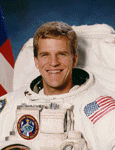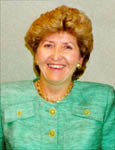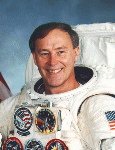
Shuttle-Mir Team Members (O - R)
Go
to
![]() Team
Members
Team
Members![]() Group (A -B)
Group (A -B)
Go
to
![]() Team
Members
Team
Members![]() Group (C - D)
Group (C - D)
Go
to
![]() Team
Members
Team
Members![]() Group (E - G)
Group (E - G)
Go
to
![]() Team
Members
Team
Members![]() Group (H - K)
Group (H - K)
Boris D. Ostroumov Profile
Boris Ostroumov from the Russian Space Agency (RSA) served as a technical director for the Phase 1 Management Working Group. This group provided the technical coordination of RSA and NASA Phase 1 activities.
![]()
 Scott
E. Parazynski Profile
Scott
E. Parazynski Profile
Astronaut and medical doctor Scott Parazynski was a crewmember on STS-86, the seventh shuttle mission to dock with Mir.
On this flight, Parazynski conducted a spacewalk with veteran Russian flyer Vladimir Titov, who was the first cosmonaut to perform an EVA in a U.S. spacesuit. The two spent five hours executing a variety of tasks, including the retrieval of four experiment packages deployed on STS-76 when the shuttle was docked with Mir, as well as a test of the Simplified Aid for EVA Rescue (SAFER).
STS-86 began on September 25, 1997, when the Space Shuttle Atlantis launched with Parazynski and his 7 crewmates, including astronaut David Wolf. Wolf remained on Mir for his 4-month residency. The rest of the crew returned to Earth on October 6 with astronaut Michael Foale, who had spent 4 ½ months on the station.
Parazynski had also expected to spend several months on Mir himself, having trained for five months at the Gagarin Cosmonaut Training Center in Star City, Russia. He was a backup for the third increment with the expectation that he would later serve as a prime crewmember. However, in March of 1995, Parazynski was deemed too tall to fit into the Soyuz capsule, which would be used as an escape vehicle in case of an emergency, and he was withdrawn from Mir training.
Additionally, Parazynski flew on STS-66 in 1994 and on STS-95 in October and November of 1998 with one of his heroes, legendary astronaut John Glenn. In an interview prior to his flight on STS-95, Parazynski discussed flying with Glenn, his own NASA career, and his optimism for the future of human spaceflight:
"I think it's a wonderful time to be alive. We're doing remarkable things in space as well as here on the ground. If someone would have told me when I became an astronaut, back in 1992, that someday I would fly up to a Russian space station and do a space walk with a Russian cosmonaut, or that one day I would fly with my hero, John Glenn, into space, that would have certainly been considered science fiction - impossible. So I think it bodes very well for the future - [towards] international cooperation aboard the International Space Station, and more long-range, towards returning to the Moon and [going to] Mars.... I think all of these things are possible, and they will happen."
Parazynski was selected to become an astronaut in 1992 and completed his training in 1993. Prior to his NASA career, Parazynski earned a Bachelor of Science degree in biology from Stanford University and graduated with honors from Stanford Medical School. His served his medical internship at the Brigham and Women's Hospital of Harvard Medical School and completed 22 months of a residency program in emergency medicine in Denver, Colorado.
![]()
 Sam
L. Pool Profile
Sam
L. Pool Profile
Sam Pool served as NASA's Assistant Director of Space Medicine in the Space and Life Sciences Directorate at the Johnson Space Center (JSC) during Phase 1. He and the flight surgeons were responsible for providing medical support to the astronauts and their families pre-flight, in-flight, and post-flight, They were also in charge of training the crews in medical techniques necessary and potentially necessary on-orbit.
Pool has worked for NASA since the Apollo Program and helped to develop a set a of medical standards for spaceflight, which are used to medically screen astronauts. In his Oral History, Pool commented on how spaceflight affects the human body and why scientists study those effects:
"Flying in space, particularly in microgravity for long periods of time, is not very friendly to the human body. There are a lot of body functions which degrade. There's a fair amount of deconditioning that goes on, and the countermeasures, including exercise, which we have used over the years really haven't solved the problem. So we're still working that puzzle very hard to try to figure out how to do better.
"[The] cardiovascular system becomes less responsive, particularly on return to gravitational field. Bone mineral is lost. Neurophysiology is definitely affected. The Russians say - and I think they're quite correct - that returning cosmonauts from long missions can't play simple games that children play, because their coordination and so on is not up to it. That's certainly been proven true now that we've begun to fly with them and look at our people similarly."
Pool has also been involved in the development of the NASA/JSC biotechnology capability, a leading edge science that will benefit the International Space Station.
![]()
Don Puddy Profile
Don Puddy was the original NASA Co-chair for the Phase 1 Crew Training and Exchange Working Group. This group developed the requirements for crew functions, programs, schedules, and crew training.
As part of his role in Phase 1, he was a participant in numerous meetings, including the one that followed the signing of the U.S.-Russian Space Agreement and NASA Administrator Dan Goldin's visit to Russia (June-July 1992). His duties also included negotiating with officials of Russian space-related organizations, as well as U.S. commercial companies and agencies.
On numerous occasions, Puddy traveled to Star City for meetings and discussions. His colleague Tommy Capps explained in his Oral History a situation where he and Puddy had to use their strong persuasive skills with their Russian counterparts to manifest an on-orbit training aid:
Capps says, "At first the Russians were very resistant to that [concept]. I remember Don Puddy [and me] [for] hours, talking about it. But then they locked on and just love it now. I mean, it's something that they think is extremely important. We were lucky that Aleksandr Aleksandrov backed us and he understood the benefits."
Capps goes on to say, "Don Puddy and I and [Yuri] Kargapolov and Aleksandrov worked really well together, because we became very good friends. We became a real team. I think one of our successes was that we could move through a lot of material very quickly. The four of us together could 'crank' and we had an awful heavy workload for a long time, so we had to move through the material."
Kargapolov says, in his Oral History, "When we started working on this joint program, my American counterpart was Donald Puddy. I would like to express my admiration and gratitude to this person. I really learned a lot from him." Puddy's 31-year career with NASA also included working with the first flight-partnership with the Russians by serving as a flight director during the Apollo-Soyuz Test Project. He retired from the NASA program in October 1995.
![]()
 Debra
Rahn Profile
Debra
Rahn Profile
Debra Rahn from NASA Headquarters served as co-chair for the Public Affairs Working Group. This group planned, coordinated, and implemented all public affairs activities. Her responsibilities included activities associated with television, news, and protocol and guest operations related to the Phase 1 Program.
During her Oral History session, Rahn spoke about the different philosophies between NASA and the Gagarin Cosmonaut Training Center, where the astronauts trained in Russia.
"[It] was their policy that they would actually charge media for access to their facilities for interviews, for tours, and that sort of thing, which, of course, is something that NASA does not do. We discussed that on several occasions. Basically we agreed to disagree. It was clearly their policy. What we did do in a compromise was that they would not charge any news media for access to our astronauts who are training there."
![]()
 Lisa
M. Reed Profile
Lisa
M. Reed Profile
Lisa Reed was a NASA training lead during Phase 1. She began her career at NASA in the training division at the Johnson Space Center, developing computer-based training programs before becoming a systems instructor. After that, she became a specialty instructor who trained astronauts on the orbiter docking system.
Part of her responsibilities in this position included training the first two cosmonauts who arrived at the NASA Johnson Space Center in Houston, Texas, as part of the cooperative agreement between the U.S. and Russia. In her Oral History, Reed shared some of the communication challenges encountered with astronauts from foreign countries. The following is an example:
"We ran into a lot of problems with slang. We Americans like our slang. We don't realize we use it as much as we do. So they would stop us. I remember one day, I was in here teaching [STS-60 cosmonaut] Sergei [Krikalev]about the hydraulic system. I was explaining to him that when we come back from orbit, they'll start one [an auxiliary power unit] prior to the de-orbit burn. It's basically just to make everybody feel good that you have one running, because you don't really need it. Just so everybody knows you have at least one of these hydraulic systems running.
"The term that all of the instructors here use is 'warm fuzzy.' I remember he stopped, and he looked at me, and he goes, 'What is this "warm fuzzy"?' And I couldn't explain it to him, because I tried to separate the words. 'Warm,' to him, was like 'near hot.' Then 'fuzzy,' we got off into talking about teddy bears and fur and it just degraded from there. I don't think that he ever quite understood what a 'warm fuzzy' was. Maybe he does now. He's been over here for a while."
![]()
 William
D. "Bill" Reeves Profile
William
D. "Bill" Reeves Profile
Bill Reeves served as a NASA flight director during Phase 1. As a flight director, Reeves was responsible for planning, directing, and controlling the activities of the Space Shuttle team during these human space flight operations. He was also a member of the first NASA consultant group to visit the Russian Control Center prior to STS-63, which was the first Shuttle-Mir rendezvous mission that occurred in February 1995.
Reeves was in the TsUP, the Russian Mission Control Center, during STS-63 assisting with the mission planning, problem solving, and negotiations. During this mission, the Space Shuttle Discovery's thruster unexpectedly began to leak fuel. Reeves had the responsibility of explaining the situation to Vladimir Solovyev and Victor Blagov, the Mir flight director and deputy flight director, as well as devising a solution that would not harm the Mir or the sensors on the attached Soyuz.
His participation in the historic partnership between the United States and Russia was not a role that could have been possible early in his career. In his Oral History, Reeves notes the difference in Russian-American relations in the 1990s versus several decades ago:
"With the fears and everything else and all of the movies you'd seen and all the stereotypes you'd been exposed to your whole life, you know, I expected to go over there and see a lot of closed doors and restricted access to everything else, and it was just quite the opposite.
"I couldn't believe it. It was just whatever you want. And we opened up to them and they opened to us and it was great, really great.
"By the way, the people, the individuals, that we've worked with so closely over the [Shuttle-Mir] years have had those discussions about the historical problems we've had in the past and the fear of each other. And now, working so closely together, we have those discussions a lot socially. We sit down and talk about it, and it's as awesome and mind-boggling to them as it is to us."
![]()
 Jerry
Ross Profile
Jerry
Ross Profile
Jerry Ross was a NASA Group Leader for the Extravehicular Activity (EVA) Working Group. This group was responsible for defining the EVA requirements and the hardware required to support the EVAs.
Ross is a NASA astronaut who has flown 6 times on the Shuttle and has participated in 7 spacewalks.
He received Bachelor of Science and Master of Science degrees in mechanical engineering from Purdue University. He served as an engineer in the United States Air Force before being selected as an astronaut in 1980.
![]() Go
to Team Members group (A - B)
Go
to Team Members group (A - B)
![]() Go
to Team Members group (C - D)
Go
to Team Members group (C - D)
![]() Go
to Team Members group (E - G)
Go
to Team Members group (E - G)
![]() Go
to Team Members group (H - K)
Go
to Team Members group (H - K)